The post Shipborne Unmanned Aerial Systems: Extending India’s Maritime Reach appeared first on Chanakya Forum.
]]>Shore-Based Maritime UAS Platforms
The IN’s shore-based UAS capability is defined by three squadrons of Israeli-origin Heron and Searcher Mk-II UAVs, based in Kochi, Porbandar, and Uchipuli in Tamil Nadu.
In order to partially meet the incessant need for enhanced MaritimeDomain Awareness (MDA), the IN, in November 2020, began operating two MQ-9B (HALE) Sea-Guardians leased from the US for a period of one year. These machines are now being operated from Naval Air Station Rajali, in Tamil Nadu, with an extended lease period. The lease of the Sea-Guardians was deemed a precursor to the proposed purchase of 10 MQ-9B Unmanned Combat Aerial Vehicles (UCAVs) each for the three Services (30 in all) for a project cost of approximately US$ 3 billion. As per the statement of the Chief of Naval Staff in December 2022, the case is being progressed, albeit with a ‘possible rationalisation of numbers involved’. In spite of the leasing/ procurement of such shore-based HALE UAS, the numbers of these land-based UCAVs would not serve to meet the IN’s holistic requirements for responsive/immediate ISTAR requirements within the area of interest of a Naval Fleet or a Task Force, especially keeping in mind the fact that the IN is required to provide maritime security along both seaboards as well as discharge its responsibility as a key component of security in the Indian Ocean Region. Such responsive capability can only be met by shipborne UAS platforms.
IN Efforts for Acquisition of Maritime UAS
The IN has traditionally operated small shipborne Pilotless Target Aircraft (PTA), for use as airborne targets, with no ISTAR capabilities. In October 2007, the IN tested the Austrian Schiebel rotary-wing camcopter from INS Sujata, an offshore patrol vessel. However, no further progress at acquisition was evident.
The IN’s efforts at acquisition of shipborne UAS date back to February 2015, when a global Request for Information (RFI) was floated for procurement of 50 Naval Shipborne UAS (NSUAS) for Intelligence, Surveillance and Reconnaissance (ISR)/MDA, anti-piracy/anti-terrorism and assistance in search-and-rescue (SR). The RFI stated the requirement for such NSUAS to be capable of operating from surface ships as small as 50 m in length, which would include even some missile boats, thus possibly necessitating that such NSUAS (or a portion thereof) be small or even hand-launched. This RFI, however, did not yield any acquisitions.
The growing need for responsive shipborne UAS capability, therefore necessitated the formulation of a fresh RFI to meet the IN’s requirements of NSUAS.
RFI 2022. Apropos the above, the IN floated a fresh RFI for NSUAS on 28 June 2022, which envisages procurement of 40 NSUAS for performing the tasks as spelt out in the previous RFI. These are to be procured under the Buy (Indian-IDDM), Buy (Indian) or Make categories of the Defence Acquisition Procedure (DAP)-2020, thus ensuring a high indigenous content, in keeping with the theme of enhancing self-reliance in the Defence industry. Other salient aspects of the RFI are enumerated below.
- NSUAS should be capable of operation from ship/shore by day/night, in low visibility conditions. It should have autonomous/manual flight modes or a combination thereof, with a ‘return home’ capability. The UAS should preferably be capable of Vertical Take-off and Landing (VTOL)/ Automatic Take-off and Landing (ATOL) and be operable from all moving ships of length greater than 100m (which would allow operation from modern corvettes, frigates and all capital ships of the IN), as well as from beaches and unprepared littoral surfaces. The NSUAS system should be tropicalised for maritime use over an operating temperature band from -20 to +55º It should have launch/‘GPS-denied’ recovery capability in wind speeds up to 15 Knots (~ 25 feet/ second). The UAS should be capable of floatation to assist in recovery at sea.
- The UAS and its payloads should be modular, interoperable within the IN and should be easy to dismantle/repair at sea, thus facilitating repair/replacement, lowering logistics burden and yielding greater time on-station. Each system would be duplicated, including the UAS, Control Stations and Ship Data Terminals/Remote Video Terminals, thus increasing operational flexibility and enhancing redundancy. The UAS should be equipped with encryption-capable primary data-link and a secondary data-link.
- The UAS should be made of composite material and have low radar/acoustics signature, for low detection probability at sea.
- Each system should be accompanied by one set of detachable payloads, including Maritime Patrol Radar (MPR), surveillance (Electro-optical {EO} and Infra-Red {IR}) and communication relay equipment, ELINT/ COMINT, Automatic Identification System (AIS- used for Identification Friend or Foe-IFF) and Automatic Dependent Surveillance-Broadcast (ADS {B}- which provides real-time precision and shared situational awareness to pilots and air traffic controllers) payloads. The MPR should be capable of detecting/tracking small/medium/large targets with Radar Cross-Section (RCS) of 10/100/upto 1000 m2 respectively, by day/night and in light rain. The day camera/thermal imager (TI) should be capable of detection up to 20 Km by day/night respectively.
- The minimum endurance with basic payload (EO/IR and AIS) should be 10 hours, with a max operating altitude of 5000 feet (1524 m) above surface level, and a range of 100 Km. The UAS should be capable of operating for at least 100 hours per month throughout the year in normal operations and 16 hours per day/ 300 hours per month for a period of at least two months in intense operations.
Global Maritime UAS
Against the backdrop of the latest RFI, it would be prudent to examine global prospects in maritime UAS, as briefly profiled below.
- Maritime Heron (MH). Israeli Aerospace Industries (IAI), a long-time partner to the Indian Defence Industry, manufactures the MH UAS. The IN presently operates the land-based Heron as mentioned above. The MH is a MALE Maritime UAS that was successfully tested for induction by the UK in May 2022. It is capable of being launched from shore/ships. The MH has Line-of-Sight mission radius of 350 Km (>1000 Km in BLOS configuration). It has a max take-off weight (MTOW) of 1430 Kg, a useful payload capacity (UPC) of 490 Kg, endurance of 45 hours, loitering speed of up to 148 Kmph and service-ceiling of 35,000 feet. Payloads include EO-TV/IR/LASER range finder/designator, MPR, AIS, COMINT/ELINT, ESM, Acoustic/Magnetic Anomaly Detectors for Anti-Submarine Warfare and user-customized payloads. The UAS is also equipped with IFF, Traffic-Collision-Avoidance System, SATCOM and Airborne /Ground Data Relay for BLOS missions.
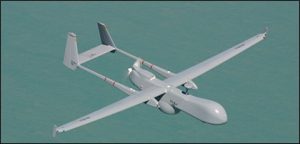
Maritime Heron: Source- iai.co.il
- Black Eagle 50. The Black Eagle 50 is a rotary-wing maritime UAS manufactured by Israeli firm Steadicopter for ISTAR/SR missions. The UAS has an MTOW of 35 Kg and UPC of 5 Kg. It has a cruising speed of 85 Kmph, endurance of 4 hours, service-ceiling of 10,000 feet and operating temperature range from -20 to +50ºC. It has a datalink range of 150 Km. The UAS can take off/land in wind speeds up to 25 Knots (45 Kmph). The 50E variant is electrically powered with an MTOW of 50 Kg, UPC of 15 Kg and service-ceiling of 18,000 feet. The 50H variant, with intermediate capabilities, is powered by a hybrid (fuel-electric) engine. Payloads include EO/IR, COMINT/ELINT, Synthetic Aperture Radar (SAR)/MPR, Light Detection and Ranging (LiDAR- use of directed LASER beams for targeting)/Video Detection and Ranging (ViDAR- use of video-assisted advanced stereoscopic imaging for target detection/tracking), communication relay, AIS and logistic payloads.

Black Eagle 50: Source- steadicopter.com
- AR-3 Long Range UAS. Tekever, a UK/Portugal-based firm, manufactures the AR-3 UAS- a compact, modular, catapult-launched, fixed-wing UAS designed for long-range ship-based maritime/land missions. It has an MTOW of 23 Kg, UPC of 4 Kg, endurance of 16 hours, cruising speed of 85 Kmph, service-ceiling of 11,800 feet and is capable of parachute/net/water recovery. It can be equipped with a beyond-line-of-sight (BLOS) data-link. The UAS is also available in the hybrid (VTOL+fixed wing) version (read more about hybrid UAS @ https://chanakyaforum.com/hybrid-uavs-the-advent-of-responsive-combat-capability/). The AR-5 is a medium-altitude, medium-endurance fixed-wing UAS optimized for ISR/patrol/SR and other critical maritime missions. It has an MTOW of 180 Kg, UPC of 50 Kg, endurance of 12 hours and cruising speed of 100 Kmph. It is SATCOM-enabled and capable of BRLOS (beyond radio line-of-sight) operation with effectively unlimited communications range. It is equipped with redundant critical flight systems, including twin engines and ATOL capabilities. Payloads of these UAS include multiple EO/IR sensors, MPR, SAR, SIGINT, AIS and rescue (life-raft deployment).


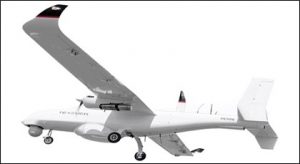
AR-3 UAS-Fixed Wing/Hybrid Versions & AR-5:Source-tekever.com
- MQ-8B Fire-Scout. US Company Northrop Grumman’s MQ-8B Fire-Scout is a VTOL maritime UAS that has ATOL capability from any aviation-capable warship/unprepared surface. It can mount a modular mission payload compatible with the US Navy’s tactical control system, with robust communications. The UAS has a combat range of 203 Km, MTOW of 1430 Kg and UPC of 320 Kg. It has an endurance of 8 hours, cruising speed of 200 Kmph and service-ceiling of 20,000 feet. The sensor payload includes a multi-mode MPR, EO/IR, moving target indicator and LASER target designator. The UAS is capable of operating as a UCAV, with Hellfire missiles/LASER-guided glide weapons. It has network-centric capabilities.
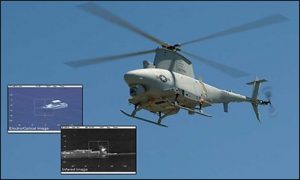
MQ-8B Showing EO and TI Feeds:Source-news.northropgrumman.com
India’s Efforts at Maritime UAS Development
While a number of private indigenous vendors are also likely to express interest in development of maritime UAS, some extant efforts at indigenous development are enumerated below.
- NRUAV. The IAI-Hindustan Aeronautics Limited (HAL) VTOL Naval Rotary Unmanned Aerial Vehicle (NRUAV) is a jointly developed rotary-wing UAS project to mount IAI’s Helicopter Modification Suite (HeMoS) on HAL’s Chetan (upgraded Chetak). The project was initiated in late 2008, to be completed within 4 years with a budget of ₹1163 crore. The UAS is capable of being launched from IN warships. The NRUAV is slated to have an MTOW of 2200 Kg, endurance of 6 hours, cruising speed of 100 Kmph, range of 150 Km and service-ceiling of 49,000 feet. The system payloads include EO, SAR and SIGINT and a possible MPR. While the project suffered technical setbacks in late 2010 due to inadequacies in landing/take-off capability from moving ships, resulting in rumours of cancellation of the contract, a full-scale prototype was reportedly developed by March 2019, and is reportedly awaiting clearance for preliminary design review.
- RUAV-200. HAL and IIT Kanpur have jointly developed the Rotary UAV (RUAV)-200- a coaxial, rotary-wing, fuel-engine UAS to meet requirements of the Indian Army for a Logistics Drone and as a maritime UAS for the IN. The RUAV has an MTOW of 200 Kg, UPC of 40 Kg, endurance of 3 hours and operating temperature range between -35 to 55 ºC. It will have a max range of 400 Km and service-ceiling of 20,000 feet. The RUAV mounts an EO day/night camera for maritime ISR and is equipped with video/data links for real-time LOS operations The relatively large size of the RUAV also makes its conversion into an armed variant a feasibility- a desirable feature for anti-piracy operations. The fully autonomous RUAV would have network-centric capabilities, thus making it ‘future ready’. HAL is presently in the process of assembling the RUAV, which should take to the skies this year.
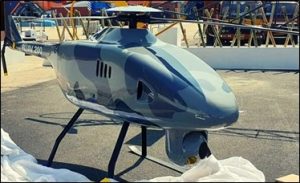
HAL’s RUAV-200: Source- theigmp.org
Conclusion
The large swathes of maritime domain that India has to safeguard/monitor demand responsive, capable and ‘mated’ surveillance capabilities, especially within our respective Naval fleets, whether they operate in the vicinity of India’s littoral waters or undertake expeditionary monitoring/security tasks far from our coasts. Apropos, shipborne Naval UAS with tailor-made capabilities for maritime ISTAR would represent force-m
The post Shipborne Unmanned Aerial Systems: Extending India’s Maritime Reach appeared first on Chanakya Forum.
]]>The post India’s Tryst With UAV: From Surveillance To Strike appeared first on Chanakya Forum.
]]>Hypothetical Scenario 1
Nov 2021: India’s (Technology Experiment Satellite) TES imagery shows presence of troops and Armoured Personnel Carriers (APCs) approximately 45 km to the East of Galwan, astride the Line of Actual Control (LAC). Confirmation of buildup needs to be urgently corroborated in order to pre-position own troops and thwart any attempt at ingress. Mission orders are relayed to affiliated UAV troop. Two Heron TP Unmanned Aerial Vehicles (UAV) are airborne and fly parallel to the LAC at 30,000 feet, utilizing their Synthetic Aperture Radar (SAR) and Electro -Optical (EO) Camera to confirm this buildup. The images are relayed in real time to the Leh Headquarters, resulting in own timely action.
Hypothetical Scenario 2
Aug 2022: A large group of terrorists is seen infiltrating through a pass on the Line of Control (LC) on the Pir Panjal Ranges in Kashmir. Physical interception by troops on ground is not possible in the required time frame, failing which the terrorists are likely to and escape into the hinterland. A decision is taken for aerial engagement of the infiltrating column. Targeting orders are issued to the Heron Unmanned Combat Aerial Vehicle (UCAV) Troop in the Area of Responsibility. UCAVs are armed, airborne and over the pass in 25 minutes. Post positive identification based on image streaming, two Precision Guided Munitions (PGMs) are fired on the infiltrating column resulting in casualties to the terrorists and foiling of the infiltration bid.
As is evident from two imaginary scenarios above, the UAV has become an indispensable part of our combat capabilities. A UAV (the term will include Remotely Piloted Vehicles and drones) is by definition an aircraft that can be remotely piloted without requiring human presence on-board. The UAV is a component of an unmanned aerial system (UAS), which would include ground-based infrastructure, communications/ guidance and command links with the UAV. Today’s UAVs are graduating to increasing levels of autonomy where it is possible for the UAV to literally ‘fly itself’ and also engage ground targets.
India’s UAV Profile- Inception to the Millennium Decade
India’s tryst with UAVs began when own Defence Research and Development Organisation (DRDO) was tasked to develop a catapult launched UAV. Consequently, Nishant UAV was developed in 1988. Nishant saw operational deployment during the Kargil War in July 1999. Though the system was operationally fielded, mission reliability issues took their toll on the continued effectiveness of the project.
In order to meet the increasing operational requirements for Reconnaissance, Intelligence, Surveillance, Target Acquisition (RISTA), the Indian Army (IA), in the late 1990s, acquired Israel’s Searcher Mark I, followed by the Searcher Mark II (68 kg payload, max speed 200 kmph, range 300km, endurance 18 hours, service ceiling 20,000 feet), with the Indian Air Force (IAF) and Indian Navy (IN) following suit.
Based on the recommendations of the Kargil Review Committee post the Kargil conflict, India went on to purchase the Heron UAV from Israel Aerospace Industries (IAI) in 2000. The Heron is a Medium Altitude Long Endurance (MALE) UAV (250 kg payload, max speed 207 kmph, range 350 km, endurance 52 hours, service ceiling 35,000 feet). It carries an array of sensors, including Infra-Red (IR) camera, intelligence systems and radars. The Heron is also capable of target acquisition, adjustment of Artillery fire and Post Strike Damage Assessment (PSDA).
India’s Developing and Future UAV Profile
Envisaged Employment. The present roles that can be assigned to an Unmanned Aerial System (UAS) in the Indian context range from operational to Humanitarian Assistance and Disaster Relief (HADR).
HADR tasks for UAVs include mapping disaster- struck areas which, in turn, can aid swift and efficient disaster response. UAVs were used effectively during the Uttarakhand floods in 2013, and subsequently during the Kerala floods in 2018.
Operational challenges present in the form of an active LC/ LAC, spanning over 4800 km. Both these boundaries are characterised by broken terrain and in a large number of places, dense vegetation. Line of sight challenges necessitate continuous surveillance over these areas by means other than static observation. In addition, Left Wing Extremism in the jungles in India’s heartland present an equally steep challenge with regards to real time surveillance and monitoring. An increasing need is also felt to attain the capability to actively engage such targets with minimum delay / collateral damage. This requirement would obviously give UAVs an edge over conventional aerial engagement.
Apropos, enter improved UAV product design and the UCAV! While the global market brooks no limits, India also needs to look inwards to create viable indigenous capability to develop these systems.
What then is India’s developing and future UAV profile?
UAVs
Rustom. The Rustom is a UAV under development by DRDO. Rustom 1 was expected to replace/supplement the Heron UAVs in service with the Indian Armed Forces. Rustom 2 is a MALE UAV which capable of performing real-time intelligence, surveillance and reconnaissance (ISR) tasks. In October 2020, DRDO flight tested the Rustom-2 and achieved eight hours of flying at an altitude of 16000 feet. The prototype is expected to achieve a height of 26000 feet and endurance of 18 hours. The Rustom 1 Project is reportedly deemed closed due to technological and cost over runs, while the Rustom 2 Project is still active and is likely to be inducted in the near future.

Rustom II: Image Courtsey- journalsofindia.com
Upgraded Heron/ Heron TP. In a major boost to strategic surveillance capabilities, the IA will deploy four unarmed Israeli advanced Heron TP (Eitan) MALE UAVs leased for a period of three years at a cost of US $ 200 million along the LAC. The UAV (payload-1000 kg, endurance 36 hours, range- over 1,000 kilometres and service ceiling in excess of 45,000 feet) is equipped with automatic taxi-take-off and landing (ATOL), Satellite Communication (SATCOM), and fully redundant avionics. Such leasing of military equipment by IA is unprecedented and has been made possible after this clause was introduced in the latest version of the Defence Acquisition Procedure. India is also reportedly planning to acquire the upgraded version of Heron UAV, which will carry long-range radars and EO/IR systems for detection and tracking of targets and also have SATCOM, Electronic Intelligence (ELINT) and SAR (Synthetic Aperture Radar) systems.

Heron TP: Image Courtsey- IAI
Tactical UAV System. While present mini UAVs held with units/ bases are ex Commercial Off The Shelf (COTS) equipment, a need is also felt to identify/ develop a tactical UAV system for use across the three Services and with the BSF and other Central Armed Police Forces for persistent all weather surveillance and intelligence gathering. The system must be suitability hardened against counter drone technologies and have the capability for runway independent operations/ auto retrieval. The system should preferably have the capability to dovetail into the existing UAS for sharing of real time information.
UCAVs
Rustom 2. The advanced version of Rustom 2 will be capable of carrying air-to-surface armament in the weaponised avatar made possible with an enhanced payload of 3000 kg.
Project Cheetah. This is a Rs. 3500 crore project for arming of the existing Heron UAVs which has been revived due to the ongoing developments along the LAC. The armament is likely to include laser guided bombs/ PGMs and air launched Anti-Tank Guided Missiles (ATGMs). In addition to collaboration with IAI of Israel, the project is also likely to incorporate indigenous solutions, thus conforming to the ‘Make in India’ theme.
Harop. Also built by IAI, this hunter-killer drone functions in a ‘kamikaze’ mode and launches itself on a pre-programmed target. This UAV is capable of loitering and has anti- radar homing capability. The IAF reportedly purchased 10 Harops from for a US $ 100 million contract. The project also has a mini version, one fifth the size of the original drone and capable of carrying smaller explosive payloads, which is worthy of consideration.
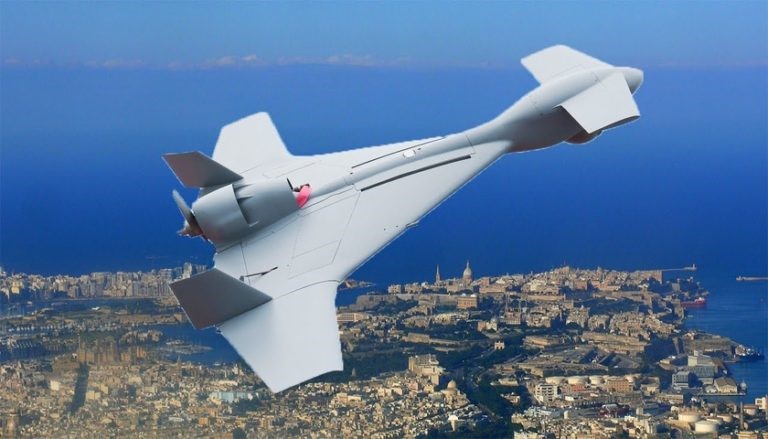
Harop: Image Courtsey- asiapacificdefencenews.com
MQ- 9B Sky/ Sea Guardian UCAV. Amid the ongoing belligerence in the region, India is set to purchase 10 MQ- 9B UCAVs each for the three Services (the IN version will be the Sea Guardian, separately configured for maritime ISR missions) for a project cost of approximately US$ 3 billion. Delivery is likely by 2023-24. The UCAVs possess endurance of upto 40 hours with a service ceiling of 40,000 feet. The Sky Guardian carries Raytheon’s multi-spectral targeting system (MTS-B) sensor suite to provide long-range ISR, target acquisition and tracking capabilities. The UCAV is fitted with a total of nine armament hardpoints. In November 2020, the IN began operating two MQ-9B Sea Guardians, leased for maritime ISR from Israel under the Acquisition Policy for one year. The IA / IAF have also reportedly identified operational bases for these UCAVs in the Eastern/ Western theatres.
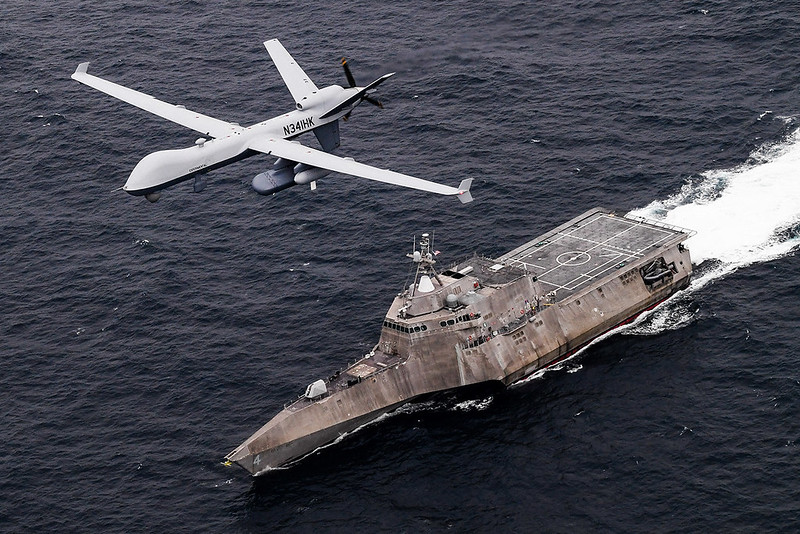
MQ 9B Sea Guardian: Image Courtsey- US Navy Pacific Command
Ghatak. Ghatak is an autonomous UCAV, being developed by the DRDO. The UCAV will be capable of firing missiles, bombs and PGMs. First flight of a scaled down test bed is scheduled in this year and that of a full-scale prototype is expected in 2024-25. The UCAV is likely to have stealth characteristics.
Niche Technologies
Swarm Technology. Recently, the IA showcased the use of swarm technology during Army Day 2021, when upto 75 drones with offensive capability identified and destroyed mock targets. Future development is likely to see massed employment of a larger number of drones in master- slave as well as independent configuration.
High Altitude (HA) Surveillance and Logistics UAVs. The IA has reportedly signed a US $20 million contract with M/s ideaForge under the Emergency Procurement clause for delivery of the SWITCH HA UAV. The Vertical Take-Off and Landing (VTOL), auto recoverable surveillance UAV is capable of day/ night feed, has a range of 15 km and is capable of take- off from an altitude of 4000m. Logistics drones to ferry loads of upto 20 kg over 10 km in high altitude in support of operations along LC/ LAC are an imperative requirement that is being looked at.
Nano/ Mini Drones and Counter Drone Technology. Due to the large incidence of drone incursions along our borders, the Armed Forces have expressed interest in counter drone technology, with capability to detect, jam and spoof adversary drones upto a 7- 10 km distance. This includes hand held jammers for shorter ranges. Nano/ mini drones (10 km range) find applicability at tactical level and in typical scenarios of fighting in built up areas.
Runway Independent UAVs. Global tender has also been floated for runway independent machines with upto 200 km range to obviate problems of real estate for landing/ take off in remote areas.
Loitering Munitions. Expression of Interest (EoI) has also been requested under ‘Make in India’ theme for loiter UAVs with 40 to 60 km range and capable of attack in ‘kamikaze’ /payload delivery mode, with programmed/ autonomous target selection. (More about Loitering Munitions can be read at https://bit.ly/3fXo051 )
Long Endurance Aerial Surveillance Platforms. Near stratospheric UAVs capable of long endurance (solar powered) for swath/ wide area surveillance have also been identified as a perspective requirement.
‘Minefield Detection’ UAVs. This has reportedly been identified as an ‘in house’ Armed Forces project for detection and marking of minefields. The technology developed could also find use in HADR for survivor tracking in natural calamities.
Conclusion
As is plainly evident from the application scenarios and identified areas of employment, UAV technology (which includes drone technology) is rapidly emerging as a frontline tool for safeguarding/ furtherance of own operations. The philosophy of being capable of influencing a situation beyond physical reach can only be driven by a technology that allows such insight and control- a technology that firmly transcends roles from surveillance to strike and through the present to future operational paradigms – the technology of the UAV!
Author

Brig Arvind Dhananjayan (Retd) has commanded an operational Brigade and has been Brigadier- in- charge Administration in a premier training facility. He has had exposure abroad on deputation to Botswana, Southern Africa as member of an Indian Army Training Team and has had extensive exposure in mentoring of Defence Forces overseas. He possesses vast instructional experience, imparting instructions in both technical aspects and tactical application of weapon systems.
The post India’s Tryst With UAV: From Surveillance To Strike appeared first on Chanakya Forum.
]]>The post Surveillance along LAC to get a boost, Indian Army plans deployment of latest Heron UAV appeared first on Chanakya Forum.
]]>India is expecting to receive four more of the most advanced version of Heron UAV from Israel, despite the delays caused due to the ongoing global pandemic and also Israel embroiled in conflict with Hamas. These Herons are much more advanced than the ones already in the inventory with advanced jamming and navigation capabilities. Heron is a MALE UAV which can carry multiple payloads as per mission requirements including SAR (synthetic aperture radar).
The acquisition of these drones had been done under the emergency financial powers granted by Prime Minister Narendra Modi-led government to the defence forces under which they can buy equipment and systems worth Rs 500 crores to upgrade their warfighting capabilities, amid ongoing border conflict with China. The deployment of these UAVs in Eastern Ladakh will be a tremendous boost to the surveillance capabilities along LAC, especially when PLA has upped its training and construction activities in the vicinity. These UAVs are capable of operating at high altitudes (30000 feet) for long hours (24 hours) at a stretch enabling continuous surveillance without terrain and time gaps.
Indian Navy has already inducted two Predator drones on lease and India is planning to buy 30 of these HALE (High Altitude Long Endurance) armed drone systems (M9Q Reaper and M9QB Sea Guardian) from USA in near future. The Unmanned Aerial Systems are force multipliers which will provide the much needed surveillance and target acquisition capabilities to Indian armed forces. The new Herons from IAI, Israel can be used for both strategic and tactical missions at the borders providing real time intelligence and monitoring capabilities.
The post Surveillance along LAC to get a boost, Indian Army plans deployment of latest Heron UAV appeared first on Chanakya Forum.
]]>